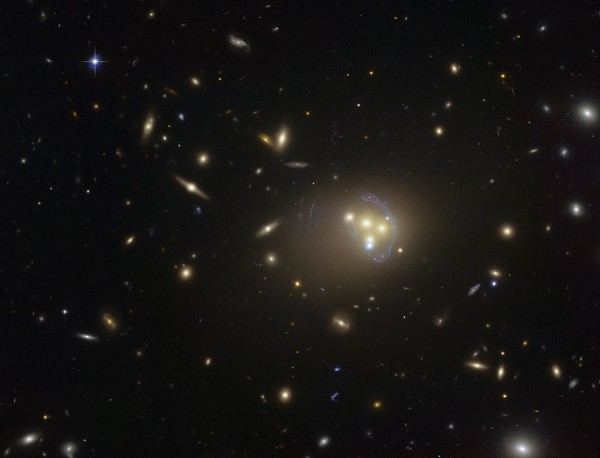Hidden Universe? Scientists Suggest Dark Matter Not Completely 'Dark' After All
| Ana Verayo | | Apr 15, 2015 03:34 AM EDT |
(Photo : ESO) The strange blue structures in galaxy cluster Abell 3827 surrounding the central galaxies are gravitationally lensed views of a much more distant galaxy behind the cluster.
In the quest to unravel the mysteries of dark matter and intriguing gravitational lenses, scientists use the MUSE (Multi Unit Spectroscopic Explorer) instrument found at the Very Large Telescope, and the Hubble Space Telescope to study four colliding galaxies inside the cluster, Abell 3827.
Like Us on Facebook
This particular cluster is so massive scientists use it to hunt for gravitational lenses.
All galaxies consist mostly of dark matter, which accounts for 85 percent of the mass of the Universe. Without it, visible material inside a spinning galaxy will shoot through space and stars will fly apart and collide into one another.
Dark matter holds all of these together via powerful gravitational forces that keep their structures intact.
Astronomers believe dark matter is out there even if it's invisible because data gained from observing gravitational lensing in which starlight from galaxies becomes warped and curved over spacetime.
When this gravitational lensing is removed from these visible galaxies, gravity allows astronomers to accurately take measurements and quantify the locations of dark matter clouds inside a galaxy cluster.
With this new method, scientists have mapped out dark matter inside four colliding galaxies. They've concluded dark matter found within each of those galaxies is lagging 5,000 light years behind compared to regular matter in those galaxies.
This lag is apparently caused by the interaction of the galactic halos of dark matter inside those galactic collisions. When galaxies collide, visible matter interacts as scientists expect. Dark matter halos, however, seem to possess a net drag effect on each other creating the 5,000 light year lag.
Lead author Richard Massey of Durham University said scientists used to believe dark matter is just there minding its own business, apart from its gravitational forces. Since dark matter is getting slowed down during this collision, this marks the first evidence of the hidden universe all around us.
This is an exciting find in the field of physics and astronomy but to understand this dark matter interaction that causes this large scale effect, more observations and computer simulations are needed.
Dark matter is out there due to the way it interacts with gravity that ultimately shapes the Universe, according to Liliya Williams from the University of Minnesota who is a co-investigator, as well. This new study now suggests dark matter can also interact with forces other than gravity.
This study was published in the journal, Monthly Notices of the Royal Astronomical Society.
TagsDark Matter Not Completely 'Dark' After All?, dark matter, ESO, VLT, Hubble Space Telescope, galaxies, dark matter not dark, gravitational lensing
©2015 Chinatopix All rights reserved. Do not reproduce without permission
EDITOR'S PICKS
-

Did the Trump administration just announce plans for a trade war with ‘hostile’ China and Russia?
-

US Senate passes Taiwan travel bill slammed by China
-

As Yan Sihong’s family grieves, here are other Chinese students who went missing abroad. Some have never been found
-

Beijing blasts Western critics who ‘smear China’ with the term sharp power
-

China Envoy Seeks to Defuse Tensions With U.S. as a Trade War Brews
-

Singapore's Deputy PM Provides Bitcoin Vote of Confidence Amid China's Blanket Bans
-

China warns investors over risks in overseas virtual currency trading
-

Chinese government most trustworthy: survey
-

Kashima Antlers On Course For Back-To-Back Titles
MOST POPULAR
LATEST NEWS
Zhou Yongkang: China's Former Security Chief Sentenced to Life in Prison

China's former Chief of the Ministry of Public Security, Zhou Yongkang, has been given a life sentence after he was found guilty of abusing his office, bribery and deliberately ... Full Article
TRENDING STORY

China Pork Prices Expected to Stabilize As The Supplies Recover

Elephone P9000 Smartphone is now on Sale on Amazon India

There's a Big Chance Cliffhangers Won't Still Be Resolved When Grey's Anatomy Season 13 Returns

Supreme Court Ruled on Samsung vs Apple Dispute for Patent Infringement

Microsoft Surface Pro 5 Rumors and Release Date: What is the Latest?










